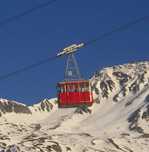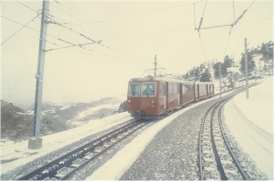Funiculars, Aerial Cable Cars,
and Cogwheel Railroads

ABOVE: A funicular car of the Marzilibahn,
which provides transportation between the city center of Bern, Switzerland and
the River Aare.
By
Durant
Imboden
Visitors to the Alps are often confused
by the terms used to describe the rail and aerial transportation systems that
haul tourists and skiers from valleys to mountaintops. In this article, I'll
describe the three basic modes: funiculars, aerial cable cars, and cogwheel
railroads.
Funiculars
A funicular cable car is a hybrid of a railroad and an elevator or lift. Two cars of
equal size and weight are attached by a cable that loops over pulleys and a
drivewheel at the upper station. As the drivewheel moves the cable, one car goes
up the track while the other goes down. The two cars pass each other (typically
on a short section of parallel tracks) at the midpoint of their journey.
Funiculars are used on slopes that are too steep for conventional railroads.
Normally they travel in straight lines, like an elevator or lift, covering
distances that range from about 100 to 1000 meters.
Aerial cable cars
 INSET
PHOTO: An aerial cablecar transports skiers to the Gemstock in Andermatt, Switzerland. INSET
PHOTO: An aerial cablecar transports skiers to the Gemstock in Andermatt, Switzerland.
An aerial cable car
consists of a reversible moving cable with a gondola suspended underneath at
each end. The gondolas convey anywhere from a few dozen to a hundred or more
passengers per trip.
Like the cars of a funicular, the two gondolas are counterbalanced. When one
gondola is at the upper station, the other is at the lower station, and the
gondolas pass each other on their ascent and descent.
(Note: Gondola lifts have
an outward resemblance to the aerial cable car but are actually more like the chair lifts and T-bars used on ski slopes.
Their gondolas are much smaller than the gondolas of an aerial cable car, and the
small two- to four-passenger capsules are suspended on a cable that runs in a
continuous loop.)
Aerial cable cars are used in locations where a funicular isn't practical:
e.g., over undulating terrain or to carry passengers from the bottom to the top
of a cliff.

ABOVE: A train of the
Gornergrat cogwheel
railway in Zermatt, Switzerland. The toothed center rail meshes with horizontal
gears on the electric locomotive.
Cogwheel railroads
A cogwheel, rack-and-pinon, or rack railway is similar to
a conventional railroad, except that the locomotives or self-propelled railcars
are equipped with horizontal gears. These gears mesh with a toothed rail between
the ordinary rails, providing traction on slopes that are too steep for
propulsion via conventional adhesion (wheel against rail).
Often, mountain railways use cogwheel or rack-and-pinion
propulsion only on sections that require the extra traction. If you're traveling
on such a railroad, you'll sense the change to cogwheel propulsion when the
train stops and the engineer or engine driver engages the cogwheel.
For an illustrated introduction to one of Switzerland's most
famous cogwheel railroads, see our article about
Pilatus Kulm.
About the author:
 Durant Imboden
is a professional travel writer, book author, and editor who focuses on European
cities and transportation. Durant Imboden
is a professional travel writer, book author, and editor who focuses on European
cities and transportation.
After 4-1/2 years of covering European travel topics for About.com, Durant and
Cheryl Imboden co-founded Europe for Visitors in
2001. The
site has earned "Best of the Web" honors from Forbes and The
Washington Post.
For more information, see
About
Europe for Visitors,
press clippings, and
reader
testimonials.
|